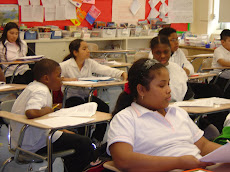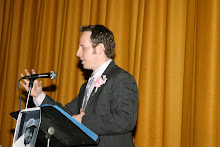RETURNING FROM BREAK
I hope everyone has been enjoying their break. We all know it was well deserved. The check off list of “Things to do” during break should have included catching up on sleep, doing something you don’t get the chance to do when you are working, catching up with friends and/or family, and preparing to return to school. For me, the things I did that I don’t normally get to do was bike ride in the park during the day, I butchered 18 holes of golf, and visited my cousins in New Jersey. I miss traveling over break. Instead, my budget limits me to spending time with my son. The choice I made to be a father requires sacrifice of some former lifestyles I had. It’s been a rewarding decision and I don’t regret anything. He gives me so much life. He grows every day and I enjoy watching him learn about himself more and more. As for preparing for your return, you should have the first three days back planned out and ready to be executed. If you have not, you are setting yourself up for a stressful end of the year.
THIS TIME OF YEAR
This is the time of year where we close out one school year and prepare for another. This year, we have all of our exams to get ready for as well. Normally, we would be done with our two highest stakes tests. I have no complaints. In fact, once we adjust to the new time of year, I think we will reflect on how much better this current schedule is compared to the old one. The challenge for us is we have to expand our efforts to ensure we progress in all three areas (preparing our students for their tests, closing out one school year, and preparing for next year). We have our grade team meetings, department meetings, and additional committees to assist in the process. We need to be strategic with our time and be as productive as possible with the common time we share to carry out our responsibilities.
Letting up on any one of those areas could have a profound effect on the great work we are doing with our students. If we do not close out this school year on a high note, then we will face constant disruptions, our students will not be prepared for the next school year, and we could potentially expand on the number of students being held over or going to summer school. By providing great instruction, endless support, and clear expectations, we can finish the school year with outstanding momentum. By failing to prepare for next year, we could face a difficult September which would put us in a position to play “Catch Up” for the entire 2010-2011 school year. I know you are with me when I cringe at the idea of fixing problems rather than preparing and executing plans. Finally, all of our tools used to measure whether the school is doing well are based on our exams. We must continue to improve year after year. We have the next two weeks and the month of May to prepare our students to reach proficiency. All efforts must be devoted to making sure our students are successful on those exams. We must work together to reinforce the areas we have identified to need support.
Departments and grades will need to plan what they want to accomplish before the year is over. This should include goals for this year and preparation for next year. For example, will the departments use their same diagnostic used this year. Math has already come to the realization that the information gathered from this assessment was difficult to consistently measure and differentiate in the classroom. I believe we will most likely end up using this year’s state exam to assess our students next year. The task of collecting data has been a learning experience this year. How do we become more successful next year especially since the Quality Review will be measuring us on how we use our data. In addition, the success coordinators were established this year. We could use our grade teams to bring this concept to full action. Judging from the number of referrals to the child study team, we are still not exploring our students enough to determine if a grade team can adjust the performance of particular students. We are still struggling to manufacture conversations about students with next steps to improve our day-to-day challenges we face with the same students.
NEXT YEAR PLANNING AND RESTRUCTURING
My goal with the restructuring was to make sure as many people as possible were taken into consideration. This task was very challenging knowing that we needed to prepare for a school year with a reduction of a number of staff members. There were a large number of staff members who wanted to preserve the grade team model. Unfortunately, additional steps have to be done to meet the criteria I outlined from the beginning of this process. Based on the proposals submitted, the feedback I collected, and research I have conducted, the following will be the restructuring plan for next school year:
The school will be made up of four houses/teams. There will be a 6th grade house, a 7th/8th grade house, a vertical house containing one class per grade, and a shared services entity. The 6th grade house will have a self-contained class, a collaborative team teaching class, and a regular education class depending on the number of students we receive in September. The second team or house has both 7th and 8th grade. It will have one 7th grade self-contain, one 8th grade self-contain, one 7th grade collaborative team teaching class, one 8th grade collaborative team teaching class, one 7th grade regular education class, and one 8th grade regular education class. The vertical house will have one 6th grade regular education class, one 7th grade regular education class, and one 8th grade regular education class. Finally, the shared service group will have the teachers of electives, the student management team, and the counseling team. This entity will service the three houses/teams within the school. The basic structure of a vertical house, 6th grade house, 7th/8th grade house, and shared service team will be the outline for the 2010-2011 school year. To close the gap on student progression from year to year, we will embrace the looping model. The following school year, 2011-2012, the staff of the 6th grade house will become a part of the 7th/8th grade house and half of the staff in the 7th/8th grade house will become the 6th grade house.
The only structural changes that will be taken into consideration are the movement of special education classes between houses, the specific way we will loop between houses, and/or increasing the number of vertical houses. From this point, we will need to develop planning teams for each house; plan the staffing and governance of each house; build the systems of communication needed to maintain equal services to all houses; create a professional development plan that takes all aspects of the restructuring into consideration; create a budget and establish the additional decision making and empowerment each house will take on; plan the instructional support needed for teachers and counselors; finalize the discipline code for next year; schedule classes, services, and decide on how long each period will be; build structures to share curriculum and improve instruction; and plan for whatever else we anticipate will make next year successful.
The purpose of restructuring was to prepare for what we are about to face in the 2010-2011 school year. Our current model did not lend itself to the anticipated budget cuts, the drop in students we have been encountering for the last two years, the changes in the Quality Review, the fact that we are faced with relearning our students each year they return to our school rather than passing on information to each other, and the slow growth we are facing right now professionally and culturally. The restructuring plan takes all of this into consideration. The plan merely lays down a foundation so we can build systems to address our deficiencies. It also gives us the opportunity to find out the ideal model for our school to embrace. By having a vertical house, a single grade house, and a shared grade house, we can compare our results. If the scores and stronger culture indicates a certain model should be used, then we can expand on the most successful one. If we do not begin measuring what works and what does not work then we will always make decisions on what we THINK is best. Unfortunately, what we think is often influenced on what we feel. If we make decisions based on what we feel, then we will spend our time reacting rather than being efficient. The new structure will answer many questions that pertain to planning time and preparing our classrooms. It will also tell us what methods are best in building strong community. I am excited to see what the results tell us. I hope you are too.
Staff Birthdays
Emmanuel Okon 1
Jacob Michelman 24
Jackie Brown 27
Quote of the Month
“People grow through experience if they meet life honestly and courageously. This is how character is built.” --Eleanor Roosevelt
Subscribe to:
Post Comments (Atom)





No comments:
Post a Comment